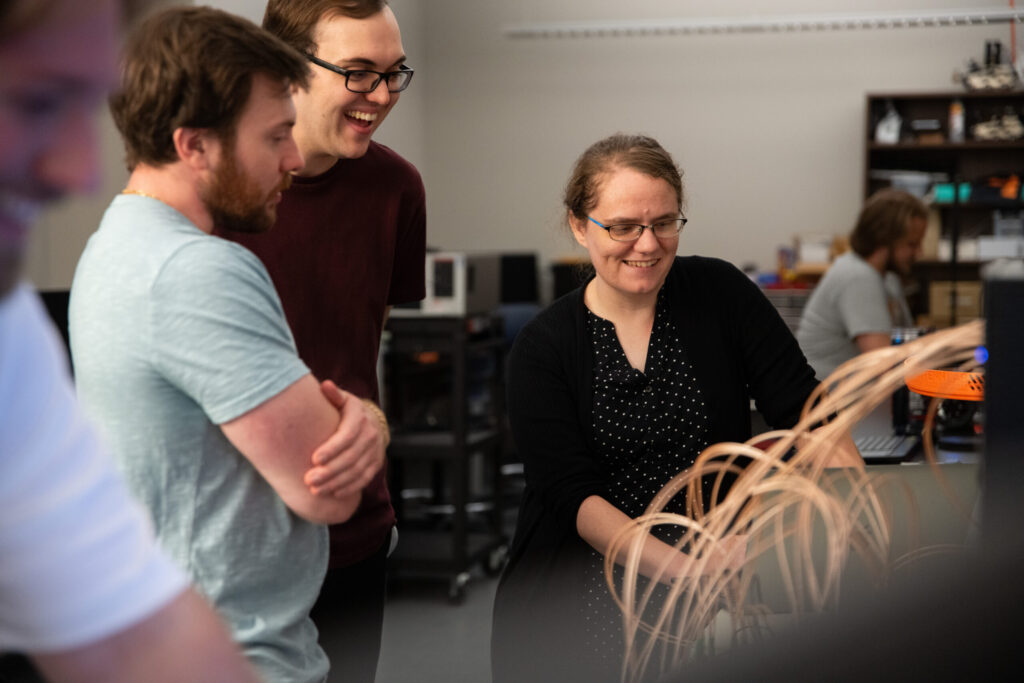UTRF is celebrating Dr. Catherine Schuman on two incredible achievements—securing a $4M grant from the National Science Foundation (NSF) to advance neuromorphic computing and co-authoring a landmark article in Nature on the future of this transformative technology.

The TENNLab Neuromorphic Computing Research Group at the University of Tennessee is leading groundbreaking research in brain-inspired computing, developing hardware and software solutions that mimic the human brain’s efficiency and adaptability. The lab’s interdisciplinary team spans computer science, electrical engineering, neuroscience, materials science, and physics, and has secured multiple patents through UTRF’s intellectual property portfolio.
TENNLab’s Core Neuromorphic Technologies
The lab has pioneered spiking neural network architectures, including:
- Neuroscience Inspired Dynamic Architecture (NIDA): A software-based 3D neural representation where synaptic delays depend on spatial distance.
- Dynamic Adaptive Neural Network Arrays (DANNA): A flexible 2D neuromorphic processor implemented on FPGA and VLSI hardware.
- Memristive DANNA (mrDANNA): An extension of DANNA that integrates memristor-based synapses for more efficient computing.
These technologies have been applied to diverse fields, including robotics, autonomous navigation, video game AI, handwritten digit classification, spoken language recognition, and cybersecurity anomaly detection.
UTRF’s Portfolio of TENNLab Innovations
UTRF has patented several key neuromorphic inventions from TENNLab, available for licensing:
- Analog Memory Read/Write Circuit Using Memristors: A method to store analog data efficiently for spiking neural networks.
- Spike Time Dependent Plasticity Implementation for Online Learning: A method using a current control mechanism to read and write from memristor based synapses, operating unsupervised while offering high reliability and component tunability.
- Scan Register Based Access Scheme for Multilevel Non-Volatile Memory: A scheme utilizing temporary scan registers to sequentially read and write data while minimizing peripheral circuitry.
- Spike Time Dependent Plasticity (STDP) Implementation: A technique for unsupervised learning in neuromorphic hardware.
- A Runtime-Reconfigurable Hardware Encoder for Spiking Neural Networks: A real-time data encoding system for integrating sensors with neuromorphic processors.
- Hierarchical Network-on-Chip (NoC) Architecture: A multi-level communication system improving power efficiency and data integrity for neuromorphic devices.
- Cryogenic Artificial Synapse & Memory Array: Cutting-edge superconducting memory and synaptic designs for ultra-low-power computing.
Schuman’s Contributions & The Neuromorphic Commons
Expanding on TENNLab’s research, Assistant Professor Catherine Schuman is advancing large-scale neuromorphic computing. In a 2025 Nature review, she and other experts outlined steps to democratize neuromorphic technology, emphasizing the need for community access.
Schuman is now working on The Neuromorphic Commons (THOR)—a project developing a nationwide neuromorphic computing platform that integrates classical and neuromorphic architectures. By making these technologies accessible to researchers, THOR aims to accelerate breakthroughs in AI, robotics, and beyond.
The Future of Neuromorphic Innovation
Through TENNLab, UTRF, and The Neuromorphic Commons, the University of Tennessee is shaping the future of brain-inspired computing. By combining patented hardware solutions with cutting-edge research and nationwide collaboration, UT is driving the next revolution in artificial intelligence and computing efficiency.